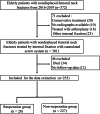Nomogram for predicting reoperation following internal fixation of nondisplaced femoral neck fractures in elderly patients
- PMID: 34470653
- PMCID: PMC8408942
- DOI: 10.1186/s13018-021-02697-8
Nomogram for predicting reoperation following internal fixation of nondisplaced femoral neck fractures in elderly patients
Abstract
Objective: We aimed to evaluate risk factors and develop a nomogram for reoperation after internal fixation of nondisplaced femoral neck fractures (FNFs) in elderly patients.
Methods: We conducted a retrospective study involving a total of 255 elderly patients who underwent closed reduction and internal fixation with cannulated screw system for nondisplaced FNFs between January 2016 and January 2019. We collected data on demographics, preoperative radiological parameters, surgery, serum biochemical markers, and postoperative rehabilitation. In addition, we performed univariate and multivariate logistic regression analyses to determine independent risk factors for reoperation, and then developed a nomogram to assess the risks of reoperation. Besides, discriminative ability, calibration, and clinical usefulness of the nomogram were evaluated using the concordance index (C-index), the receiver operating characteristic (ROC) curve, calibration curve and decision curve analysis (DCA), respectively. We employed bootstrap method to validate the performance of the developed nomogram.
Results: Our analysis showed that among the 255 patients, 28 (11.0%) underwent reoperation due to osteonecrosis of the femoral head (14 cases), mechanical failure (8 cases) or nonunion (6 cases). All of the 28 patients underwent conversion surgery to arthroplasty. The multivariate logistic regression analysis demonstrated that preoperative posterior tilt angle ≥ 20°, Pauwel's III type, younger patients, preoperative elevated levels of alkaline phosphatase (ALP), preoperative hypoalbuminemia, and early postoperative weight-bearing were independent risk factors for reoperation. In addition, the C-index and the bootstrap value of the developed nomogram was 0.850 (95% CI = 0.803-0.913) and 0.811, respectively. Besides, the calibration curve showed good consistency between the actual diagnosed reoperation and the predicted probability, while the DCA indicated that the nomogram was clinically valuable.
Conclusions: Our analysis showed we successfully developed and validated a nomogram for personalized prediction of reoperation after internal fixation of nondisplaced FNFs in elderly patients. This model would help in individualized evaluation of the need for reoperation and inform strategies aimed at eliminating the need for the reoperation.
Keywords: Elderly; Femoral neck fractures; Nomogram; Nondisplaced; Reoperation.
© 2021. The Author(s).
Conflict of interest statement
All the authors declare that they have no conflict of interest with any organization that sponsored the research.
Figures





References
-
- Dolatowski FC, Frihagen F, Bartels S, Opland V, Šaltytė Benth J, Talsnes O, et al. Screw fixation versus hemiarthroplasty for nondisplaced femoral neck fractures in elderly patients: a multicenter randomized controlled trial. J Bone Joint Surg Am. 2019;101(2):136–144. doi: 10.2106/JBJS.18.00316. - DOI - PubMed
MeSH terms
Grants and funding
LinkOut - more resources
Full Text Sources
Medical

